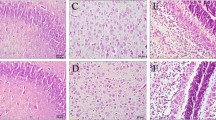Abstract
Introduction
The purpose of this study was to evaluate the diagnostic value of conventional magnetic resonance imaging (MRI), proton magnetic resonance spectroscopy (1H-MRS), and diffusion-weighted imaging (DWI) for neonatal bilirubin encephalopathy.
Methods
We collected conventional MRI in 24 neonates with neonatal bilirubin encephalopathy. We performed 1H-MRS and DWI sequences to nine of the 24 patients and seven age-matched healthy control subjects. Multiple-voxel 1H-MRS data were acquired using PRESS pulse sequence with TE = 135 ms and TR = 1500 ms. The spectroscopic regions of interest were the bilateral basal ganglia and thalamus with a 1.0 mL spatial resolution. The data from DWI were collected by using a single shot-spin echo-echo planar imaging sequence with TR/TE: 2900/98, and imaging regions were also focused on the bilateral basal ganglia and thalamus.
Results
Nineteen of the 24 patients had abnormal T1-weighted image hyperintensity in the globus pallidus, but these lesions appeared as normal T2-weighted image intensity in the same region. Ten of the 24 patients had T1-weighted image high signal intensity in the subthalamic nucleus and appeared as normal intensity in the region for the T2-weighted images. The peak area ratios of NAA/Cho and NAA/Cr were significantly decreased (t-test, P < 0.05) in the patients compared to the controls in the basal ganglia.
Conclusion
Conventional MR imaging and 1H-MRS are important complementary tools in the diagnosis of neonatal bilirubin encephalopathy. The study provides important information for applying these MR modalities to evaluate neonates with bilirubin encephalopathy.




Similar content being viewed by others
References
Govaert P, Lequin M, Swarte R et al (2003) Changes in globus pallidus with (pre) term kernicterus. Pediatrics 112:1256–1263
Coskun A, Yikilmaz A, Kumandas S et al (2005) Hyperintense globus Pallidus on T1-weighted MR imaging in acute Kernicterus: is it common or rare? Eur Radiol 15:1263–1267
Sugama S, Soeda A, Eto Y et al (2001) Magnetic resonance imaging in three children with kernicterus. Pediatr Neurol 25:328–331
Steinborn M, Seelos KC, Heuck A et al (1999) MR findings in a patient with kernicterus. Eur Radiol 9:1913–1915
Clarke CE, Lowry M (2001) Systematic review of proton magnetic resonance spectroscopy of the striatum in parkinsonian syndromes. Eur J Neurol 8:573–577
Watanabe H, Fukatsu H, Katsuno M et al (2004) Multiple regional 1H-MR spectroscopy in multiple system atrophy: NAA/Cr reduction in pontine base as a valuable diagnostic marker. BMJ 75:103–109
Rutherford M, Counsell S, Allsop J et al (2004) Diffusion-weighted magnetic resonance imaging in term perinatal brain injury: a comparison with site of lesion and time from birth. Pediatrics 114:1004–1014
Barkovich AJ, Miller SP, Bartha A et al (2006) MR imaging, MR spectroscopy, and diffusion tensor imaging of sequential studies in neonates with encephalopathy. Am J Neuroradiol 27:533–547
Oakden WK, Moore AM, Blaser S, Noseworthy MD et al (2005) 1H-MR spectroscopic characteristics of kernicterus: a possible metabolic signature. Am J Neuroradiol 26:1571–1574
Groenendaal F, Grond J, Vries LS et al (2004) Cerebral metabolism in severe neonatal hyperbilirubinemia. Pediatrics 114:291–294
Wennberg RP (2000) The blood-brain barrier and bilirubin encephalopathy. Cell Mol Neurobiol 20:97–109
Turkel SB, Miller CA, Guttenberg ME et al (1982) A clinical pathologic reappraisal of kernicterus. Pediatric 69:267–272
Rodrigues CMP, Sola S, Castro RE et al (2002) Perturbation of membrane dynamics in nerve cells as an early event during bilirubin-induced apoptosis. Lipid Res 43:885–894
Harris MC, Bernbaum JC, Polin JR et al (2001) Developmental follow-up of breastfed term and near-term infants with marked hyperbilirubinemia. Pediatrics 107:1075–1080
Shapiro SM (2003) Bilirubin toxicity in the developing nervous system. Pediatr Neurol 29:410–421
Thurnher MM, Bammer R (2006) Diffusion-weighted MR imaging (DWI) in spinal cord ischemia. Neuroradiology 48:795–801
Lansberg MG, Thijs VN, O’Brien MW (2001) Evolution of apparent diffusion coefficient, diffusion weighted, and T2-weighted signal intensity of acute stroke. Am J Neuroradiol 22:637–644
Zheng WB, Liu GR, Li PL, Wu RH (2007) Prediction of recovery from a post-traumatic coma state by diffusion-weighted imaging (DWI) in patients with diffuse axonal injury. Neuroradiology 49:271–279
Provenzale JM, Sorensen AG (1999) Diffusion-weighted MR imaging in acute stroke Theoretic considerations and clinical applications. AJR 173:1459–1467
Barkovich AJ, Westmark KD, Bedi HS et al (2001) Proton spectroscopy and diffusion imaging on the first day of life after perinatal asphyxia: preliminary report. AJNR Am J Neuroradiol 22:1786–1794
Acknowledgements
We are grateful to Chen Wei and Xiong Zeng for providing assistance.
Conflict of interest statement
We declare that we have no conflict of interest.
Author information
Authors and Affiliations
Corresponding author
Rights and permissions
About this article
Cite this article
Wang, X., Wu, W., Hou, B.L. et al. Studying neonatal bilirubin encephalopathy with conventional MRI, MRS, and DWI. Neuroradiology 50, 885–893 (2008). https://doi.org/10.1007/s00234-008-0423-5
Received:
Accepted:
Published:
Issue Date:
DOI: https://doi.org/10.1007/s00234-008-0423-5




